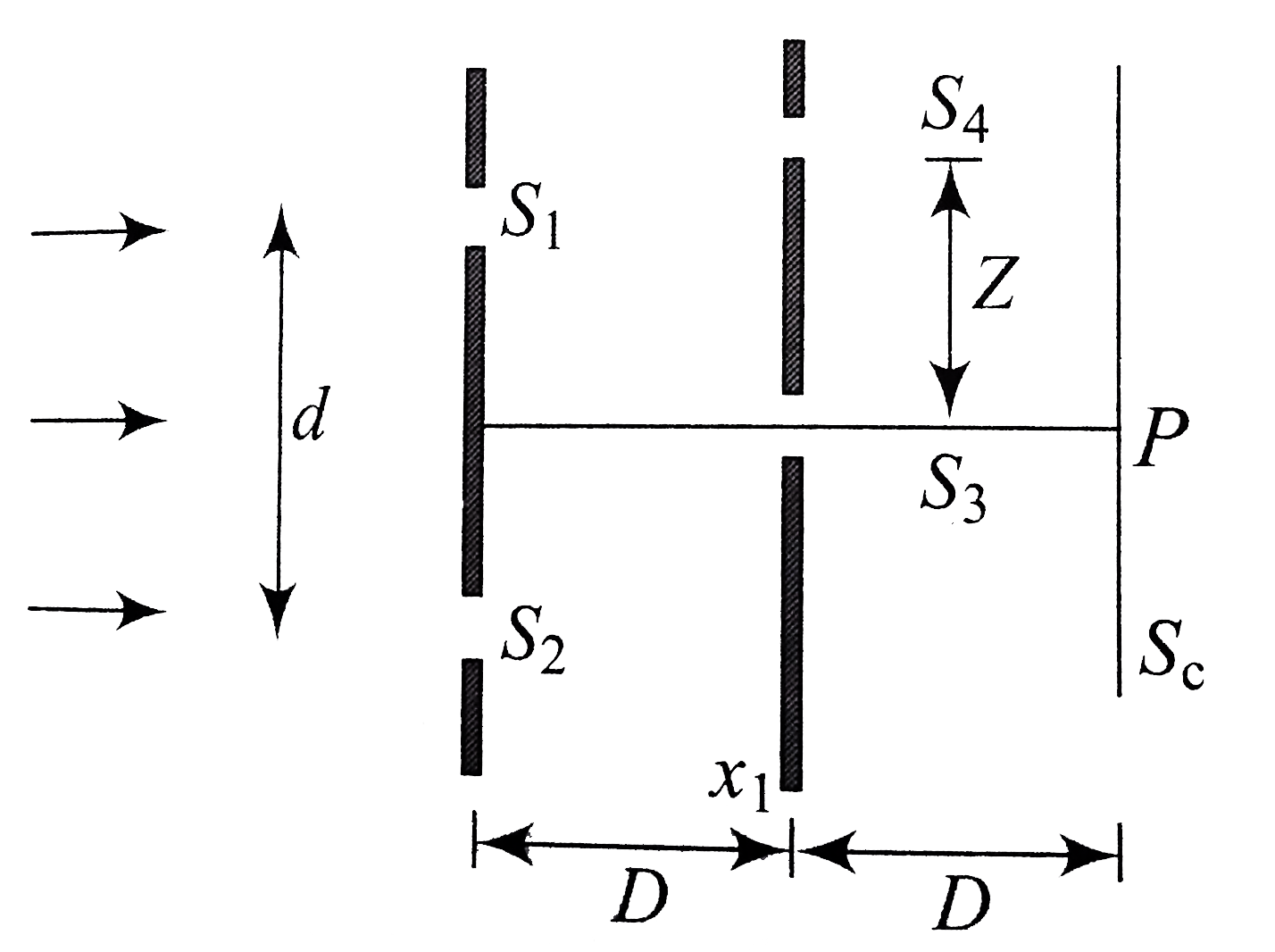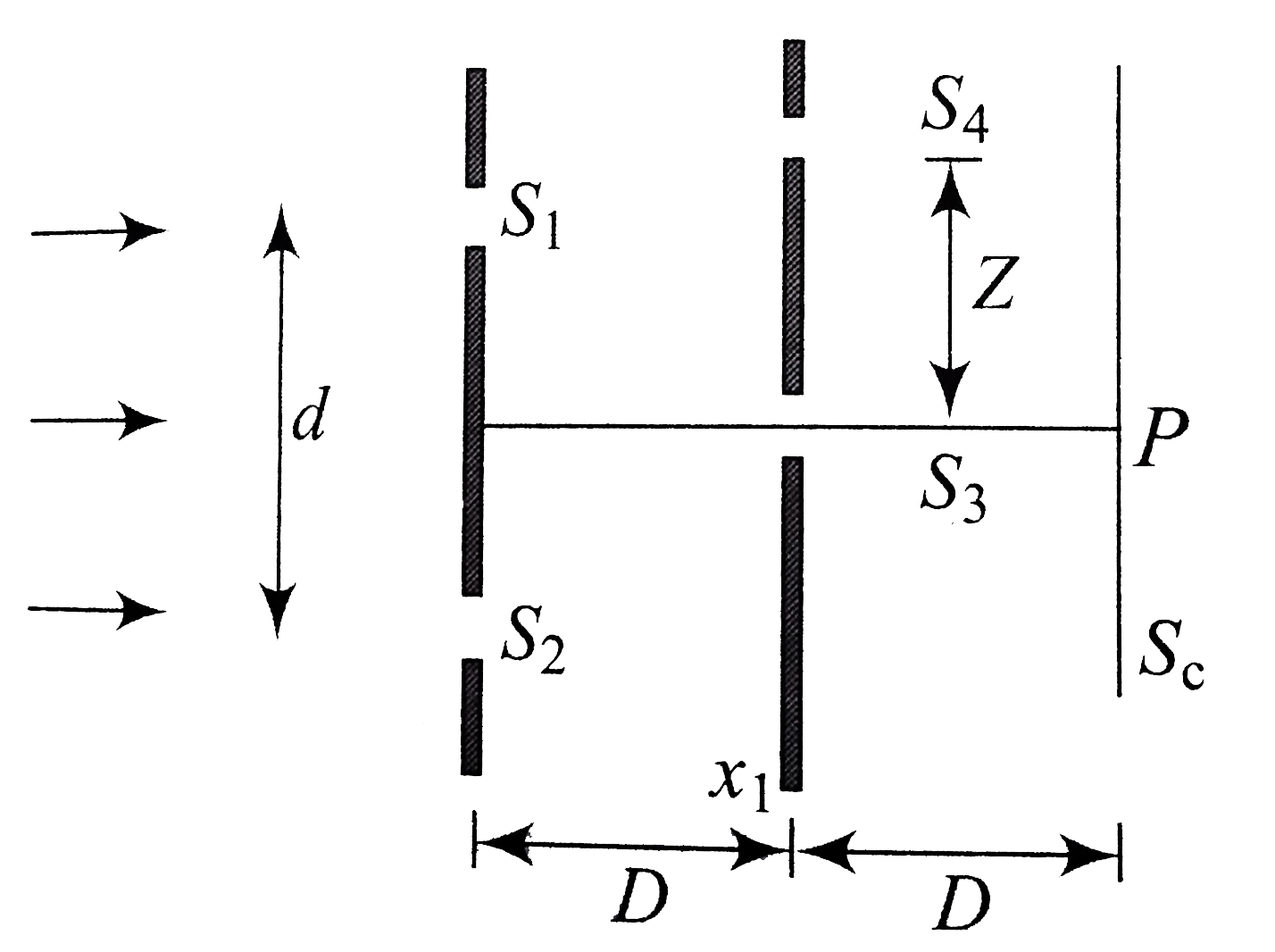_E01_101_Q01.png)
Two slits S1 and S2 on the x-axis and symmetric with respect to y-axis are illuminated by a parallel monochromatic light beam of wavelength λ. The distance between the slits is d(>>λ). Point M is the mid point of the line S1S2 and this point is considered as the origin. The slits are in horizontal plane. The interference pattern is observed on a horizontal palte (acting as screen) of mass M, Which is attached to one end of a vertical spring of spring constant K. The other end of the spring is fixed to ground At t=0 the plate is at a distance D(>>d) below the plane of slits and the spring is in its natural length. The plate is left from rest from its initial position. Find the x ad y co-ordinates of the nth maxima on the plate as a function of time. Asuume that spring is light andplate always remains horizontal.
The correct Answer is:nλD'd,−D where D'=D+MgK(1−cosωt)
Fringe pattern forms on a screen the distance of the nth maxima in x-direction i.e., x coordinates is nλD' and y-position is decided by the SHM of spring.
D'=D+Mgk(1−cosωt)
Topper's Solved these Questions
- BOOK - ALLENCHAPTER - WAVE OPTICSEXERCISE - Exercise 5 A (Previous Years Questions)17videos
WAVE OPTICS
- BOOK - ALLENCHAPTER - WAVE OPTICSEXERCISE - Exercise 5 B (Previous Years Questions)19videos
WAVE OPTICS
- BOOK - ALLENCHAPTER - WAVE OPTICSEXERCISE - Exercise 4 A (Conceptual subjective Exercise)9videos
WAVE OPTICS
- BOOK - ALLENCHAPTER - UNIT & DIMENSIONS, BASIC MATHS AND VECTOR EXERCISE - Exercise (J-A)7videos
UNIT & DIMENSIONS, BASIC MATHS AND VECTOR
Similar Questions
A narrow slit is illuminated by a parallel beam of monochromatic light of wavelength λ equals to 6000 Å and the angular width of the central maxima in the resulting diffraction pattern is measured. When the slit is next illuminated by light of wavelength λ, the angular width decreases by 30%. calculate the value of the wavelength λ.
View SolutionS is the size of the slit, d is the separation between the slits and D is the distance of slits from a plane where Young's double slit interference pattern is being observed . If λ be the wavelength of light, then for sharp fringes, the essential conditional is
View Solution
Knowledge Check
- Question 1 - Select One
In Young's double slit experiment, ten slits separated by a distance of 1 mm are illuminated by a monochromatic light source of wavelength 5×10−7m. If the distance between slit and screen is 2 metre, then separation of bright lines in the interference pattern will be :
A0.5 mmB1.0 mmC1.5 mmD1.75 mm - Question 2 - Select One
In Young's double slit experiment the two slits are d distance apart. Interference pattern is observed on a screen at a distance D from the slits. A dark fringe is observed on the screen directly opposite to one of the slits. The wavelength of light is
AD22dBd22DCD2dDd2D - Question 3 - Select One
For a parallel beam of monochromatic. Light of wavelength 'λ' diffraction is produced by a single slit whose width 'a' is of the order of the wavelength of the lightl. If 'D' is the distance of the screen from the slit, the width of the central maxima will be
A2DλaBDλaCDaλD2Daλ
Consider the situation shown in fig. The two slits S1 and S2 placed symmetrically around the central line are illuminated by monochromatic light of wavelength λ. The separation between the slit is d. The ligth transmitted by the slits falls on a screen S0 placed at a distance D form the slits. The slit S3 is at the central line and the slit S4 is at a distance z from S3 Another screen Sc is placed a further distance D away from Sc Find the ratio of the maximum to minimum intensity observed on Sc

If z=λD2dView SolutionConsider the situation shown in fig. The two slits S1 and S2 placed symmetrically around the central line are illuminated by monochromatic light of wavelength λ. The separation between the slit is d. The ligth transmitted by the slits falls on a screen S0 placed at a distance D form the slits. The slit S3 is at the central line and the slit S4 is at a distance z from S3 Another screen Sc is placed a further distance D away from Sc Find the ratio of the maximum to minimum intensity observed on Sc

If z=λD4dView SolutionConsider the situation shown in fig. The two slits S1 and S2 placed symmetrically around the central line are illuminated by monochromatic light of wavelength λ. The separation between the slit is d. The ligth transmitted by the slits falls on a screen S0 placed at a distance D form the slits. The slit S3 is at the central line and the slit S4 is at a distance z from S3 Another screen Sc is placed a further distance D away from Sc Find the ratio of the maximum to minimum intensity observed on Sc

If z=λDdView Solution_E01_054_Q01.png)
A monochromatic light source of wavelength λ is placed at S. three slits S1,S2 and S3 are equidistant from the source S and the point P on the screen S1P−S2P=λ/6 and S1P−S3P=2λ/3. if I be the intensity at P when only one slit is open the intensity at P when all the three slits are open is-View SolutionWhite light is used to illuminate the two slits in a Young's double slit experiment. The separation between the slits is b and the screen is at a distance d(>>b) from the slits At a point on the screen directly in front of one of the slits, certain wavelengths are missing some of these missing wavelengths are
View Solution

